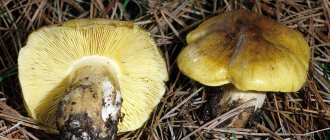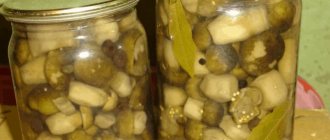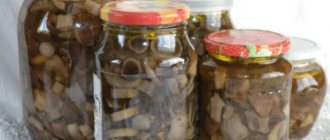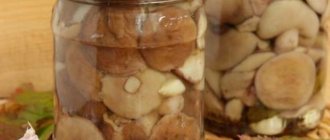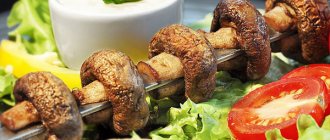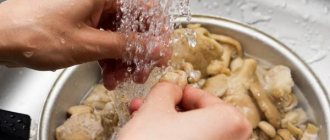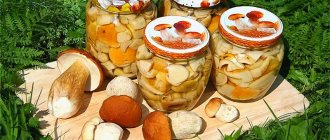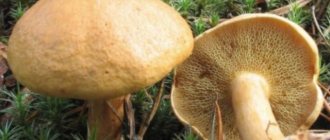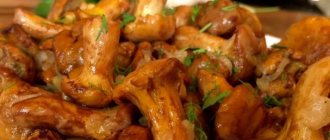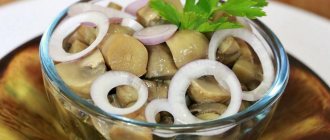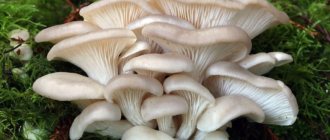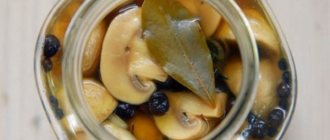With the arrival of warmer days, more and more people are trying to get out of the city.
Some go to the dachas, and some go to the forest for barbecue or mushroom picking. You can't fool experienced mushroom pickers. But it wouldn’t hurt for novice foresters to know what edible mushrooms look like. The forest is rich in various mushrooms, let's focus on bluelegs. Blueleg, few people are familiar with this mushroom, it has a pleasant taste and is easy to prepare. This mushroom has many names: cyanosis, blue root, and the official name is lilac-legged row. Inexperienced mushroom pickers pass by this mushroom because it has a strange color; despite its intimidating appearance, the mushroom has a good taste.
Traditional recipe for pickled mushrooms blue legs for the winter
You can learn how to marinate blue leg mushrooms from a recipe that is considered traditional for Russian cuisine.
To prepare it we will need the following products:
- mushrooms – 1 kg;
- water – 500 ml;
- salt – 2 tbsp. l.;
- granulated sugar - 3 tbsp. l.;
- bay leaf -3 pcs.;
- black pepper – 12 peas;
- allspice – 7 peas;
- leaves of currant, oak, cherry;
- head of garlic – 1 medium piece;
- vinegar 9% - 2 tbsp. l.
Boil the peeled mushrooms separately in water for 20 minutes and drain in a colander to drain the liquid well.
Pour 1 liter of water over the blue leg, let it boil, add salt, sugar, bay leaf, a mixture of black and allspice, clean oak, cherry and currant leaves. Let the mushrooms simmer over low heat for 10 minutes.
Peel and finely chop the garlic, add to the mushrooms, then pour in the vinegar. Let the marinade and mushrooms boil for 5-7 minutes and remove from heat.
Pour into glass jars, roll up, cover with a blanket and leave in this position until completely cooled. After which the mushrooms need to be taken to the basement or put in the refrigerator.
This recipe for pickled blue leg mushrooms will become a culinary masterpiece on your table. Show a little imagination, add spices to your taste and you will have your own version of the marinade for blue legs.
Cleaning and heat treatment
To properly prepare the collected bluelegs, preserving the fruity aroma characteristic of mushrooms, it is necessary to thoroughly clean, soak and boil.
1) After arriving from the forest, the mushrooms are sorted one by one, removing plates filled with spores and sand. The procedure allows the body to quickly digest the product without disrupting the gastrointestinal tract.
2) The next stage is removal of the leg. The lower part is not used in cooking, getting rid of excess weight even at the time of collecting edible prey. The trick allows you to save space to collect a larger volume of purple-legged row.
3) After complete cleaning, the mushrooms are soaked in a salted solution for 2-3 hours, checking every hour to ensure that the water remains cold.
4) Upon completion of the procedure, the caps are washed, placed in a deep boiler, and filled with water. Boil twice over low heat until boiling, draining the resulting broth and adding fresh water. During the final boiling, add a pinch of citric acid, which allows you to preserve the unusual shade, which raises not only your appetite, but also your mood.
5) The product, ready for further preparation, is thrown into a colander and washed. Finish the heat treatment by lightly drying it on a tray.
Cooking recipes
Bluelegs can be eaten after any type of heat treatment. It is not recommended to eat it raw. It tastes very much like champignons and sometimes chicken.
It is very good to pickle and marinate it, and you can also prepare very tasty fried mushrooms or dry them for soup.
When dried, this mushroom can be stored for quite a long time due to its dense pulp structure.
A few important rules when cooking any mushrooms:
- You need to sort through the mushrooms as quickly as possible after they have been collected.
- It is necessary to clean the mushrooms.
- You need to keep the mushrooms in salt water to get rid of any insects that may be in them.
- Mushrooms need to be washed under running water.
- Boil for fifteen minutes and drain the water.
- After this, you can boil, fry, salt and make mushroom pies.
When cooked, bluelegs emits a bright fruity aroma, so dishes made from it turn out unusual and delicious.
Fried potatoes with mushrooms
The most popular dish using mushrooms.
For this recipe, frying in vegetable oil is best. The mushrooms must first be washed, peeled and boiled for fifteen minutes.
After this, you need to cut the potatoes into small cubes, the onions into small rings, and cut the mushrooms into slices. You need twice as much potatoes as mushrooms. Add spices to taste: pepper, salt, herbs, bay leaf.
Marinated mushrooms
For marinating, you only need bluecaps. They need to be washed, peeled and boiled for fifteen minutes in salted water. The water must be drained.
For the marinade you will need:
- 1 liter of water
- 2 tablespoons salt
- 2 tablespoons sugar
- 2 bay leaves
- Branches of cherries and currants
- 8−10 black peppercorns
- 5 cloves garlic
You need to pour this marinade over the mushrooms and let them cook for another twenty minutes. Before the end of cooking, add one tablespoon of vinegar and you can roll the mushrooms into jars.
Similar edible species
Before choosing a day for a trip to the forest, you should carefully study similar types of mushrooms that fall into the category of edible and false, unsuitable for consumption. The first is to collect and eat safely, following the rules for preparing the collected pulp before the main cooking.
- No. 1 – Violet row
It belongs to the category of conditionally edible mushrooms that require repeated boiling before eating. It is colored pinkish-white or brownish-red, depending on the age and size of the fruit. On the reverse side it has white or purple plates. The leg is light, in rare cases it has a pinkish tint. The aroma is floral. In size and fleshiness, they are almost identical to bluelegs.
- No. 2 - Purple cobweb
An edible mushroom with a frightening purple color. In rare cases, it has manifestations of blue and orange. Most often, red shades color the part of the leg hidden behind the cap.
- No. 3 – Purple row
Conventional mushroom of the Lepista genus, Govorushka family. In comparison with the purple-legged row, it has a rich shade of the cap, corresponding to the name. In most cases, there is an orange tint on the top of the head.
- No. 4 – Lilac varnish
It has several distinctive features from the blue leg, namely: snow-white spores, a fibrous leg, and a thin cap that is inferior in fleshiness.
What mushrooms does blueleg resemble?
The peculiarity of the blueleg is considered to be that it can only be confused with other edible mushrooms: for example, with the purple row or May mushroom. The weed row is also similar to it, but it is much smaller, and the cobweb is purple, which has a blanket under the cap. If you confuse them, don’t worry – all these mushrooms are edible.
Bluefoot is a bit like some poisonous saprophytes. For example, goat and white-violet spider webs can be distinguished from it by the yellowish color of the flesh and an unpleasant odor, and mycena by the rough edge of the cap and white spore powder. The fibrous row is somewhat similar to the bluefoot, although it
thinner and a characteristic ash-gray color.
Harm and contraindications
Despite numerous advantages, bruises also have disadvantages - a small number of contraindications. The main prohibition is serious problems of the digestive tract, which are accompanied by low acidity. The use of home remedies can lead to exacerbation of chronic diseases.
Another contraindication is pregnancy. The female body may react to the consumption of mushrooms with prolonged diarrhea or bouts of vomiting. Doctors warn that children are also prohibited from eating or using home remedies based on bluepods. Eating bruise can result in poisoning.
The disadvantage of bluelegs is that these mushrooms are too difficult to digest. If you make mistakes in their preparation or storage, consumption will lead to severe abdominal pain, cramps, severe vomiting, and hallucinations. Overeating is also considered dangerous, as it can cause increased gas formation or bloating.
Bluefoot is used in cooking, cosmetology and traditional medicine recipes
What does this mushroom look like?
Young bluelegs are very attractive, resembling round buns on top. After all, their cap is fleshy, dense and semicircular. It is convex, and the edge turns slightly inward. Its color is most often matte cream or yellowish with purple streaks. And young mushrooms have a bright purple cap. Its surface is always smooth and shiny, but in the absence of rain it becomes dry and fades. The size of the cap can reach 25 centimeters.
The plates of bluepods are large, thin and frequent; in young mushrooms they are white with
violet hue, and with age they become yellowish or purple. And the spore powder is pale pink. The pulp is dense and fleshy, turns purple when broken and emits a pleasant fruity smell. Old mushrooms or those that have survived frosts lose their purple tint and become yellowish. It is better not to take such saprophytes, because, in addition to the fact that they are easily confused with inedible ones, they become tasteless.
Botanical description of the mushroom
Bluefoot (two-colored mushroom (lilac-legged), boletus, blue root, Lepista personata) is a conditionally edible mushroom from the rower family. It is easy to recognize by its characteristic color and other distinctive features: A flat-convex cap of a light yellow, slightly purple hue. Its average diameter reaches 10 cm, but there are also giant mushrooms with a cap up to 25 cm in diameter.
Its surface is smooth; At the bottom of the cap there are plates, yellowish-cream in color; The leg is slightly thickened at the base, with a smooth surface. Its length is usually no more than 10 cm, thickness is about 3 cm. In young specimens, remnants of the “spread” in the form of flakes are visible on the stem and a fibrous structure is noticeable.
The color is bright, lilac or gray-violet, sometimes with a bluish tint. The main characteristic of the bluefoot is its bright colors. This scares away mushroom pickers. But the nutritional properties are good. It has a pleasant taste, somewhat similar to champignon. There are other names for this mushroom:
- lilac-legged row;
- two-color row;
- bluefoot;
- captain;
- blue root;
- Lepista personata;
- Lepista saeva.
Description of individual parts of the mushroom
- Cap of the lilac-legged rower has a cushion-shaped, flat-convex cap, which flattens slightly with age. The cap is fleshy, with edges curved inward, which in older specimens may turn slightly outward. Its surface is smooth and slightly oily to the touch, its color is yellow-brownish with a slight purple tint. The diameter of the cap can reach up to 15–16 cm. It will be useful for you to read about which mushrooms are edible and poisonous, which edible mushrooms grow in autumn and May, and also learn how to test mushrooms for edibility using folk methods.
- Plates The two-color row belongs to the lamellar mushrooms: its plates are wide, frequent, free or attached in a notched manner. The color of the plates is yellowish, cream, gray or pinkish cream. Young specimens have whitish plates.
- Pulp Blueleg pulp has a dense and thick structure, which becomes looser with age. Its color is light lilac, gray-violet, gray and grayish-brown are also found. The pulp has a pleasant mealy aroma, and its sweetish taste resembles champignon. If you decide to cook older specimens of bluelegs, then before doing this you should remove the lower spore-bearing layer of the cap - the plates, since the numerous mature spores contained in them are practically not digested.
- Leg The main distinguishing feature of a two-color row is its leg. It has a clear purple tint, and the younger the specimen, the more expressive the color. Also, the legs are grayish-purple, and sometimes even bluish. There are mushrooms with a light stalk and distinct bluish and purple fibers located on it. The stem of young mushrooms is covered with flakes with a clear fibrous structure, which represent the remains of the blanket. With age, its surface becomes smooth. The shape of the leg is smooth, dense, slightly thickened at the base. Its height reaches 10 cm and diameter 3 cm.
Growing at home
This mushroom is very popular among mushroom pickers for its unusual aroma and taste, so many people want to grow it on their property.
Bluefoot is one of the representatives of mushrooms that will grow well in the garden, the main thing is that the soil is fertile.
The garden bluefoot is rarely worm-eaten and does not require special conditions, as it tolerates even frost well.
There are two ways to grow this beautiful mushroom at home:
- Pour the water in which the raw mushrooms were washed, along with the remains of the caps and stems, into the place where you plan to grow a mushroom clearing. Old overripe mushrooms at the end of the mushroom season are very suitable for these purposes; they will need to be soaked in water for a day and then poured into the mushroom clearing.
- You can grow a mushroom plantation by planting mycelium in the ground. To do this, you need to very carefully cut off the top layer of the mycelium along with the mushrooms growing on it and plant it in the ground. If the soil contains humus and manure, then with a high probability it will be possible to harvest a harvest of bluelegs in this place next year.
Blueleg is a very tasty and productive mushroom. It has quite a lot of fans among experienced mushroom pickers. And those who tried it for the first time also did not remain indifferent.
It is perfect for pickling and marinade, frying and boiling. Its unusual fruity aroma sets it apart from other mushrooms.
A distinctive feature of this mushroom is that it can be successfully grown in your own area and reap a fairly decent harvest in the same place for several years.
Habitat
Bluefoot grows throughout the European part of Russia, as well as Kazakhstan. This fungus can be collected until frost, as it withstands the first frost well .
Bluelegs usually grows under coniferous trees or ash trees. It often grows in groups of several mushrooms. If the mycelium is not disturbed, the blue leg can grow several times in the same place. Mushroom pickers who know mushroom places collect more than two hundred kilograms of bluelegs per season.
It grows well in places where there is humus, so they can be found in places where manure and humus accumulate, as well as on fallen leaves and near fences. Rows even grow in meadows where livestock graze.
Features of the mushroom:
- A very rare fruity smell that is unique to this mushroom. Some experienced mushroom pickers say that this smell is similar to pineapple.
- Only young bluelegs will be tasty. The old ones pick up moisture and become unpleasant to the taste and completely unhealthy.
- The leg has a purple color. It is quite dense and long.
- Young mushrooms are completely purple.
- Bluelegs can only be confused with edible mushrooms. It looks like a purple row and a May mushroom.
- Grows well in the garden in fertilized soil.
What soil does this mushroom prefer?
It loves open forests, but the largest specimens grow where there is a lot of humus. After all, for bluelegs it doesn’t matter whether there are trees; the earth is more important to them. They love humus, sandy or semi-sandy soils. Bluelegs can often be found on abandoned farms, near piles of garbage or manure, on rotted leaves and fallen pine needles. They love to grow near fences and even in gardens and orchards. It is believed that rowers are most often found in open areas, especially in meadows and other grazing areas.
Collection
This mushroom prefers to grow in alkaline soils. You can find such land in a meadow, forest clearing or abandoned agricultural plot.
Similar properties are inherent in pastures throughout the country. Bluelegs grow in large colonies. In appearance they resemble rows. Among the people, this arrangement of mushrooms is called the witch’s circle.
The blue leg has become widespread within Russia and some European countries. You can find her in the forest of America. Blue root is found in both the northern and southern parts.
Blue roots are collected in the fall. This happens at the very beginning, that is, in September. It is better to collect bluelegs when dry weather conditions have established.
Otherwise, the mushrooms become slippery and stick to your hands. Regardless of the color that the row has, it has many fans. Having tried the taste at least once, a person joins the bluelegs lovers. If mushroom pickers see rows of mushrooms in the middle of the forest, they collect them in a basket. A variety of delicious dishes are prepared from these rows.
The row can have two colors. It is classified as a member of the ordinary family. There are several types of mushrooms. Inexperienced fungi are often interested in what time and where to collect bluepods.
Initially, you need to study the photographs and descriptions of the rows. This family is represented by several mushrooms. Blue roots grow near bodies of water: rivers or lakes. You can find them in the grass located near the farm.
Blue roots can grow in pastures and meadows. Rows begin to appear in mid-spring and end by early summer. For the second time this year, mushrooms will be collected closer to the end of August.
They continue to grow until frost hits. Sometimes people manage to collect two harvests of blue root. To understand what a mushroom looks like, you need to look at the photo.
Among the rows there are inedible varieties. However, there are no deadly species. The most severe disruption that will occur in the functioning of the body is a disorder of the digestive system.
The person suffers from weakness, diarrhea, and stomach pain. In some situations, loss of consciousness is possible. Poisoning appears half an hour after eating.
The maximum time that can pass for symptoms to form is two hours. The duration of the illness is from three to seven days. In the end, recovery comes. No deaths were recorded.
Features of the blueleg mushroom
A description of this saprophyte can rarely be found in popular literature. Some authors classify the row mushroom as a conditionally edible mushroom, but among mushroom pickers it is considered very tasty. Its characteristic feature is a strong fruity smell, which not everyone likes, but lovers say that it is similar to anise and is quite pleasant. Young rows are the most delicious; old ones become watery, loose and often lose their characteristics. How do you know what's ahead?
Are you really a blueleg mushroom?
Description of the purple row
Rowers live in regions where coniferous and deciduous tree species predominate, mainly in the European part of the Russian Federation, Siberia, China and the Far East.
It is distinguished by its unusual purple color. The large (up to 20 cm in diameter) convex cushion-shaped cap of a young mushroom gradually becomes spread-out or depressed, with a wavy-curved edge. The smooth purple skin fades over time and becomes brown. Drought also affects the color - in wet weather the mushroom takes on a dark purple hue.
Structure and features of the species
The mushroom has several corresponding names: lilac lepista, naked, violet, blue, tit. It belongs to the conditionally edible saprophyte mushrooms. Depending on the region, it may appear in forests in September. Prefers to grow on leaf, hay or pine litter.
Due to its rich purple color, lepista is often confused with inedible mushrooms of a similar color. Therefore, you should be especially careful when collecting this variety of mushrooms of the Ryadovkov family.
hat
Leg
It is because of this that this type of rowing got its name.
Often the leg has a really lilac, or even violet color. Blue is less common. Length - from 5 to 12 cm, usually the legs of this mushroom are not high, this is another distinctive feature of it. Thickness – up to 3 cm in diameter.
The stems of young mushrooms have a fibrous structure, but the adult blue root has a completely smooth stem. At the base it acquires a thickening, which, however, is not always noticeable.
Controversy
The spore powder is pinkish-yellow. It has the shape of small ellipses.
The plates of the lilac-legged rowers differ in the frequency of their arrangement and have a pinkish or brown tint. Very young mushrooms are white.
Pulp
White, with a barely noticeable lilac tint. It has a fairly dense structure and a pleasant, slightly fruity smell.
In old mushrooms, the flesh becomes loose.
How to recognize a mushroom
To recognize titmice and not confuse them with poisonous mushrooms, you should know the following characteristics:
- The cap of the row is convex, usually large in size, sometimes reaching 20 cm in diameter, with shiny skin. The reverse side is lamellar, purple in color; in adult mushrooms, the plates are reddish-brown and can be located very close to each other.
- The cylindrical leg is smooth, up to 8 cm tall. In young mushrooms it is dense, while in adults it has small cavities.
- The mushroom got its name from its color. However, in mature fruits the color fades and becomes lavender.
- The spores are elliptical in shape, the spore powder is whitish-pink in color.
- The mushroom pulp is dense, gray-lilac in color, soft, creamy. Has a persistent anise smell.
Cooking methods
You can cook mushrooms with blue legs in different ways: fry, cook soups, make fillings for pies and dumplings, salt, pickle, bake with different ingredients, dry, freeze and much more. During heat treatment, the mushroom practically does not decrease in volume.
Fans of this product recommend boiling it for at least thirty minutes to thereby protect themselves from poisoning.
It should never be consumed raw.
There are many recipes on how to cook bluelegs mushrooms deliciously and without fear for your health.
In any cuisine in the world you can find dishes using mushrooms. It's always tasty, satisfying and unusual. They can easily replace meat dishes in terms of nutritional value. Here are some pretty good recipes.
Fried rows
The dish will turn out tasty and aromatic if you add a little sour cream or heavy cream. There are no special proportions, it all depends on individual taste and preference.
Set of required products:
- lilac-legged rows;
- sweet cream butter;
- sour cream;
- bulb onions;
- salt.
Separate the fruiting body of the rows from the stems and rinse thoroughly to remove dirt, remove the top film from the caps. Cut as desired and boil for 10 minutes.
Remove them with a slotted spoon, place them in a heated frying pan, stirring, and let the excess liquid evaporate. Add oil and finely chopped onion. Fry until golden brown, add sour cream and simmer for 15 minutes over low heat. The finished dish can be sprinkled with herbs.
Mushroom noodle soup
It is better to cook it with chicken meat. You can cook the noodles yourself or buy ready-made ones, but only egg noodles, since they will not lose their attractive appearance in the finished dish.
You will need the following ingredients:
- 2 liters of water;
- chicken;
- rows;
- a couple of potatoes;
- 200 g noodles;
- bulb;
- salt, bay leaf, ground pepper.
The first step is to cook the chicken. Boil the rows separately, draining the water twice.
Add diced potatoes to the broth and cook until tender. Add rows and noodles to it. Season with spices and bring to a boil. Remove from heat and let steep for 10 minutes. When serving, you can add sour cream and herbs.
Appetizer in batter
This dish is prepared very quickly and disappears from the table just as quickly. It is somewhat reminiscent of pies, only “lazy”.
You need to prepare:
- small rows - about 1 kg;
- 0.5 l of sour milk;
- a pinch of soda;
- 2−2.5 cups flour;
- salt;
- vegetable oil for frying.
Wash the mushrooms, remove the stems. Cook for 5 minutes in salted water, remove and dry.
Mix kefir and soda in a suitable container. Sift the flour, knead the dough. It should resemble sour cream in consistency. Dip the caps into it and fry in a heated frying pan on both sides until golden brown. It is better to eat hot.
Julienne with rice and egg
This dish came to us from French cuisine. It is prepared in special portioned cocotte makers, but if they are not available, it can be prepared in one large form. It is served piping hot.
You will need the following products:
- rows;
- onion;
- boiled rice;
- raw eggs;
- sweet cream butter;
- cream;
- hard cheese;
- salt pepper.
Chop clean mushrooms randomly. Chop the onion and fry in oil until soft.
Add mushrooms, boiled rice and a little cream. Season with spices. Transfer to cocotte bowls, crack one egg into each and sprinkle with grated cheese on top. Bake in the oven at 180°C for 20 minutes. Serve in cocotte bowls, sprinkled with herbs on top.
Mushroom cutlets
This dish will undoubtedly appeal to those who have given up meat or are fasting. The products are the simplest, and the results are excellent.
The composition of the products is as follows:
- bluelegs;
- bulb onions;
- semolina;
- breadcrumbs;
- egg;
- spices - to taste;
- a handful of chopped walnuts;
- vegetable oil for frying.
Boil mushrooms in salted water for 20 minutes. Place in a colander and allow all liquid to drain.
Grind in a meat grinder or grind in a blender. Add finely chopped onion, a spoonful of semolina and crackers, egg, spices and nuts. Knead well. Place a spoon into a hot frying pan with oil and fry on both sides until browned.
Characteristic features of the variety
Blue leg, blue leg, two-colored row, blue leg row, purple leg row, or blue root - all these are names of the same mushroom. It received its names due to its color and unique location. After all, bluelegs grow in a row, tightly pressed against each other.
Appearance and photo
The lilac-legged row, which is the scientific name of the mushroom, is collected with pleasure by experienced mushroom pickers, because it is very tasty. Beginning mushroom pickers should familiarize themselves with the photo and carefully study the description of the mushroom so as not to confuse it with saprophytes, which under no circumstances should be eaten.
The bluefoot stands out with its shiny, rather dense cap, wrapped inward. This makes it resemble a round bun.
Structure and species differences
Let's look at what this view looks like in more detail. The cap usually reaches 10 cm in diameter, but there are also quite large ones - up to 25 cm. The color is light yellow, with a slight purple tint. It is important to note that color may vary. It depends on weather conditions, place of growth and age of the mushroom.
As already noted, the edges of the cap are rolled up, but in old fruits they may be turned inside out. The hat is slightly oily to the touch and sticky in rainy weather. The plates are located underneath it. They are most often yellowish in color, but can also be cream, pinkish-cream, or gray-cream. The plates themselves are large and freely arranged.
The legs are quite thick at the bottom (up to 3 cm), club-shaped, smooth. The length generally does not exceed 10 cm. The unusual bright purple, violet or gray-violet color and fibrous structure are the main differences between young mushrooms.
The flesh of the Blue Leg is of the same purple color. When characterizing it, one can also note the density and thickness of the structure. With age it becomes more loose. A very unusual aroma. Some mushroom pickers compare it to the aroma of pineapple.
Place of distribution, rules and conditions of collection
Bluelegs can be found almost throughout Russia (except for the Far North). They also grow in North and South America, Europe, and Kazakhstan.
Lilac-legged rowers love to settle in meadows and pastures. But they are not very fond of forests, preferring a lot of light. If they can be found there, it is only under deciduous trees. They also like places with organic fertilizer, such as compost pits and abandoned farms, peat and chernozem soils. You can also collect Blue Legs in forest ravines with rotten leaves.
They grow very close to each other, in whole families. Therefore, it is difficult not to notice them. There were cases when up to 20 kg of crops were harvested in one place. Experts recommend going “hunting” from April to October in dry weather. During the rainy season, the fruits are slimy and sticky, which makes them unpleasant to the touch, but they tolerate light frosts down to minus 5 degrees very well.
Eating
The Blue Leg mushroom is conditionally edible, but despite this, it is very tasty and is somewhat reminiscent of champignons and even chicken. It is fried, salted, pickled, boiled, dried, that is, eaten in any form except raw.
Useful properties and restrictions on use
Blueleg is not only tasty, but also very healthy. It is perfect for those who watch their diet and count calories: 100 g of this product contains only 22 kcal. In addition, it contains many vitamins and minerals. That is why the lilac-legged rower is recommended to be consumed during the cold season.
Bluefoot improves the functioning of the heart and blood vessels, normalizes blood pressure, strengthens the immune system, has anticancer, antimicrobial and antibacterial effects, and has a beneficial effect on all organs. However, people suffering from chronic diseases of the gastrointestinal tract and liver should refrain from eating mushroom dishes.
How to cook this mushroom
Although some experts classify the mushroom as a conditionally edible mushroom, it can be eaten in any form except raw. After all, one of the most delicious saprophytes is bluelegs. This mushroom tastes like champignons and even a little chicken. Most often it is pickled and salted, but it can also be fried and even dried. After all, the dense fibrous pulp allows bluelegs to be stored in dried form for a long time.
The most important thing is that before cooking, this mushroom must be rinsed well under running water. After all, frequent platelets and the love of bluelegs for sandy soils lead to the fact that small grains of sand get clogged under the cap. It is also recommended to remove the skin. Fans say that these mushrooms don’t even need to be cooked first, but experts still recommend boiling them for 10-15 minutes and draining the water before cooking. Then the bluelegs can be pickled, salted, fried, or used as a filling for pies. Their peculiarity is the specific pleasant smell of anise, which intensifies during heat treatment.
Medicinal and beneficial properties
The blue leg is valued not only for its pleasant taste, but also for its medicinal qualities. Thanks to their rich composition, which combines vitamins, polysaccharides and minerals, mushrooms have numerous beneficial properties. Folk remedies based on bluepods will help:
- strengthen blood vessels, increase their elasticity, improve blood flow;
- suppress the activity of pathogenic or pathogenic bacteria;
- normalize blood sugar levels;
- lower blood pressure;
- increase physical activity, get rid of fatigue;
- cope with regular headaches or migraines;
- activate the body's defenses, strengthen the immune system;
- normalize the functions of the digestive tract;
- improve the functioning of the heart muscle and cardiovascular system;
- remove toxins from the body, reduce the concentration of free radicals.
The bruise mushroom is used to prepare extracts, extracts, decoctions and tinctures. Home remedies are taken orally or applied externally.
Appearance of the bluefoot
This is a rather beautiful mushroom that resembles a round bun. The cap is round, convex, turned inward, quite dense and has a creamy tint. Young mushrooms can be completely purple.
The cap is dense, smooth, shiny and up to thirty centimeters in diameter. Its flesh is dense and purple. When broken in half, the fruity smell of pineapple is felt. If the mushroom is already old and has had enough rain, it may have a yellowish tint. It is better not to take them, because they become unsuitable for food, and in this form they can easily be confused with poisonous ones.
Bluelegs has a slight resemblance to poisonous saprophytic mushrooms, but upon closer examination, the latter can be distinguished by the yellowish color of the flesh and an unpleasant, pungent odor.
Is it possible to salt and ferment
The fourth category of mushrooms is not suitable for pickling and fermentation, as it does not have the characteristic mushroom taste necessary to combine with crunch. Culinary experts advise preferring the classic marinating method to avoid getting into the trap of high expectations.
The lilac-legged rower, popularly called the blue-legged mushroom, has a description and photo that allows you to distinguish the edible mushroom from similar and false species. There are plenty of recipes for cooking at home, which will surely appeal to lovers of a varied diet.
Dish recipes
The most delicious and favorite food by many is fried potatoes with onions and mushrooms.
It is best to fry them in vegetable oil, but you can also fry them in lard. It is advisable to boil the bluefish a little first and let the water drain. Cut the potatoes into slices, onion into rings, cut large mushrooms into two or four parts. There should be about half as many of them as potatoes. 5 minutes before readiness, add spices and herbs to taste: dill, pepper and bay leaf.
Pickled blue leg is very tasty. This mushroom is pickled without legs. After you have cleaned and washed the caps, cook them for 15 minutes and drain the water. Pour the marinade over the caps and cook for another 20 minutes. For the marinade, you need to take two tablespoons of salt and sugar per liter of water, several leaves of laurel, currants and cherries, 10 black peppercorns and 5 cloves of garlic. Five minutes before the end of cooking, add a spoonful of vinegar - and the delicious mushrooms are ready.
Sources
- https://grib-info.ru/pererabotka/marinovat-griby-sinie-nozhki.html
- https://LivePosts.ru/articles/food-drinks/gribyi/grib-sinyaya-nozhka-osobennosti-opisanie-i-retsepty
- https://fb.ru/article/131939/sinenojka—grib-syedobnyiy-opisanie-foto-sinenojek
- https://tomat.guru/recepty-blyud/gribnye-blyuda/gotovim-vkusno-griby-sinenozhki.html
[collapse]
Interesting Facts
- Bluefoot is considered a delicacy in some countries: it is grown and exported.
- Mushroom powder is used in cosmetology to prepare lotion, which reduces sebum production;
- Bluefoot can be cultivated indoors or in the garden.
- Blueleg mushroom has a powerful antiviral effect.
Blueleg is a common mushroom with an unusual color and has good taste. Excellent for consumption boiled, fried and pickled. It is noteworthy that mushrooms grow in large groups. In one hunt you can collect more than 10 kg. Before collecting, it is important to familiarize yourself with row doubles, since most of them are poisonous.
Sources
- https://znay.co/205-grib-sinyaya-nozhka.html
- https://sveklon.ru/fioletovaya-ryadovka
- https://GriboWiki.ru/eatable/ryadovka-lilovonogaya.html
- https://gribydacha.info/ryadovka-lilovonogaya-ili-sinenozhka/
- https://gribnik.info/grib-sinenozka/
- https://ferma.expert/griby/grib-sinyaya-nozhka/
- https://gribysobiraem.info/rjadovka-lilovonogaja-uznavaemyj-predstavitel-gribnogo-carstva/
Answers to common questions
Mushrooms are boiled for 15-20 minutes in water with added salt. The readiness of bluelegs can be determined by how they are located in the pan. If done correctly, they will drown. After boiling the bluelegs, the water should be thrown away and should not be eaten.
The blue leg mushroom is very unusual. With its amazing color, it sometimes frightens inexperienced mushroom pickers. However, it is suitable for human consumption. Blueleg is very tasty boiled, fried, pickled, it is added to a wide variety of dishes. It is important to remember that in nature there are mushrooms similar to this one. Since some of the lookalikes are poisonous, you need to be vigilant when collecting.
In our forests it is not so rare to find a “blue leg” mushroom. It is classified as edible, but because of its extravagant appearance it often scares people away. However, it can be prepared - how and with what, you will read below.
Application
Official medicine has an ambiguous attitude towards mushrooms. In Eastern countries there are entire schools of healers who work exclusively with mushrooms, but in Europe this is all in its infancy, because We are used to relying more on traditional medicine.
Application in medicine
The lilac-legged row is used to make preparations for diabetics, antibiotics and drugs to combat tuberculosis.
Description of the beneficial properties of lilacfoot:
- antibacterial;
- antimicrobial;
- anticancer;
- immunomodulatory;
- improves heart function;
- anti-inflammatory;
- stabilizes blood pressure;
- normalizes blood sugar (glucose) levels;
- strengthens the walls of blood vessels;
- removes radionuclides and isolates them;
- cleanses the liver of waste and toxins;
- activates the heart and supplies blood to the blood vessels of the brain.
In order not to get sick from ARVI, you should introduce rowing into your diet. The extract of the purple stem row is used in dietary supplements. The Chinese actively use the mushroom in medicinal mixtures and drugs for cancer of the female genital organs.
The lilac-legged row is used in medicine
The presence of a wide range of vitamins helps with beriberi disease, restores the immune system and stabilizes the body, especially in winter and spring, when there is a shortage of fresh vegetables and fruits.
A unique mushroom helps with diseases of the gastrointestinal tract and genitourinary system, improves the functioning of the heart and spleen. Thus, the gray row destroys cholesterol plaques, cleans the walls of blood vessels and transforms adipose tissue into physiological fluid and glycerol.
Edible yellow row prevents the development of dermatophytosis of the skin and hair. For your information. Dermatophytoses are infectious diseases of keratinized tissues that are caused by fungi, representatives of the genera Trichophiton, Microsporum (Dermatophytes group, imperfect fungi Fungi imperfecti).
Orange mushrooms contain a huge amount of vitamin D and carotene. They are allowed to be used by children from a certain age, after 14 years.
Application in cosmetology
Powder is made for cosmetic purposes. To do this, the mushrooms are dried and ground to a powder. This powder is used to make a lotion for the skin and face. For acne, this is an indispensable medicine. It regulates sebum secretion and removes irritation.
The powder is added to belongings and creams as a dietary supplement.
